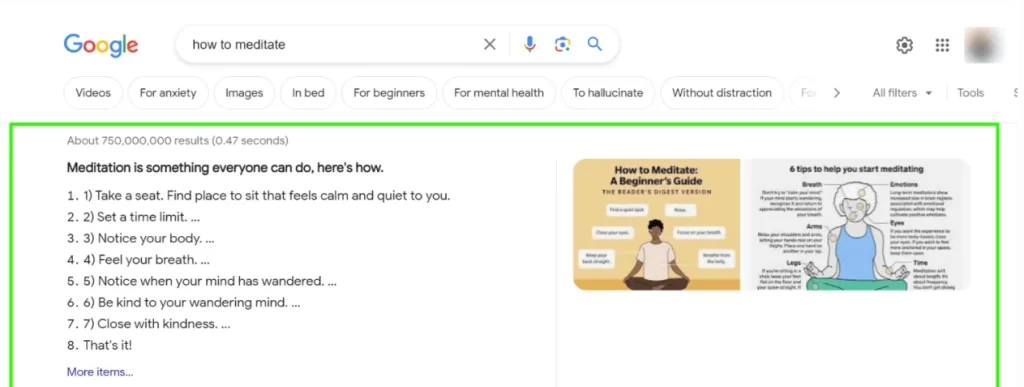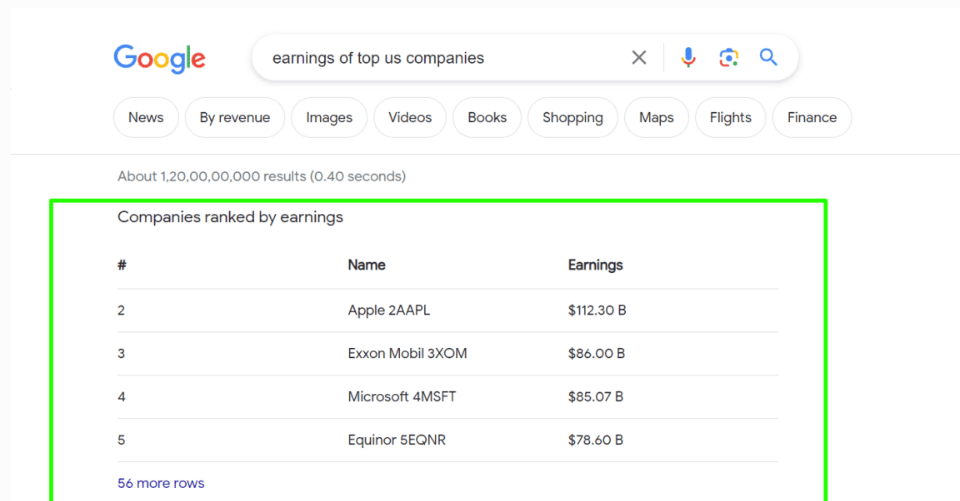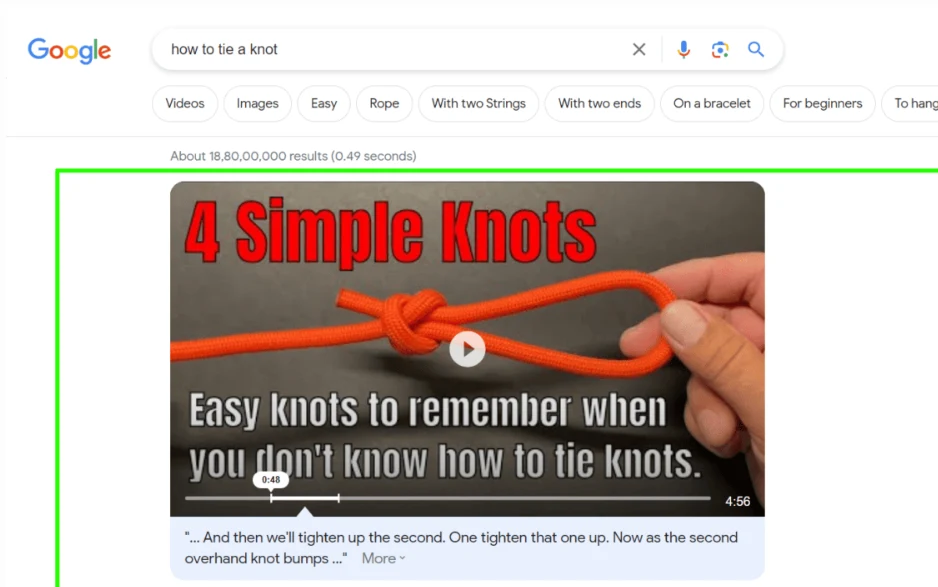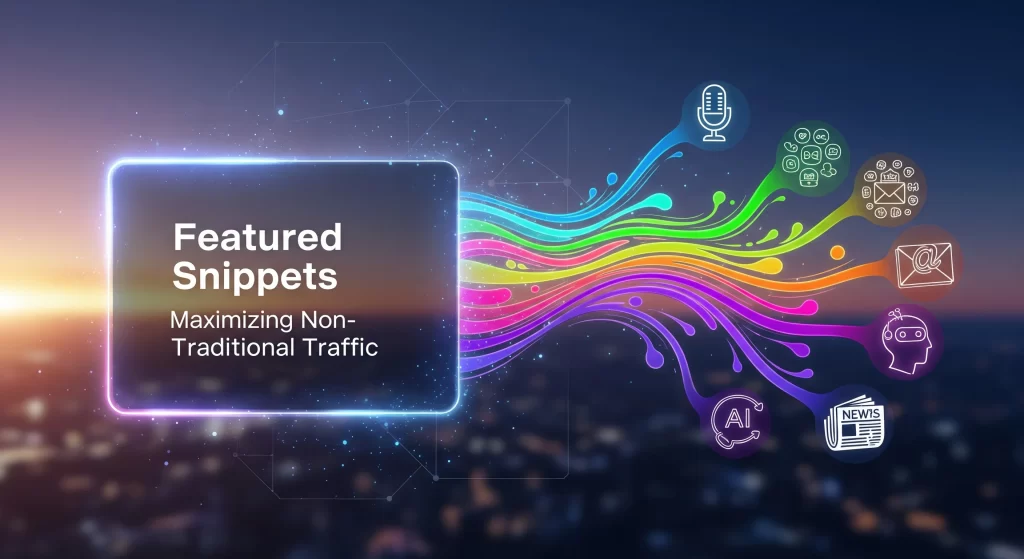In 2025, featured snippets have taken the limelight. Some are happy, some are not, but who cares? Because it’s here and smart ones will mold their practices to fit into it. So, this blog is dedicated to those smart ones who are willing to change their ways to shine in featured snippets.
Here, we’ve covered the basics from what are featured snippets to how you can make your content appear in it.
Trust us, even if you’ve heard this term for the first time, by the end of this blog, you’ll become a master. Let’s get started!
What Are Featured Snippets?
What are featured snippets? Simply put, featured snippets are quick, concise answers automatically pulled from web pages and displayed in a special box that appears at the top of Google’s search results, often called position zero.
These snippets can appear in different formats like paragraph, list, table, or even video. They are designed to instantly answer a user’s question, reducing the need to click through to a site (though many users still click for more details).
The first time Google reintrodued featured snippets was back in 2018 in a very long blog. They explained what are featured snippets, and when & why do they appear.
Why Featured Snippets Matter for SEO
For content creators and marketers, optimizing for featured snippets is a strategic game‑changer. Here’s why:
- More visibility, even above #1 organic results: Position zero outranks the usual top search results, increasing exposure dramatically.
- Higher click-through rates (CTR): Featured snippets boost CTR. Studies show snippets grab up to 35% of clicks, and in some queries, up to ~8–25% of all user clicks.
- Authority and trust: Google trusts the content it displays in featured snippets. When your content appears there, it enhances your brand’s credibility, and even attracts backlinks as other sites cite your snippet content.
- Voice search optimization: Since digital assistants often read out featured snippets, optimizing for them also improves your reach in voice‑search queries.
That said, featured snippets are dynamic. Ownership can change frequently. Google may replace your snippet with another page if it deems that offers a better answer.
And Google often deduplicates listings, so if your page holds a featured snippet, it typically won’t also appear as a regular result on page one.
Types of Featured Snippets & How They Fit Queries
Understanding formats is key to optimizing for featured snippets effectively.
1. Paragraph Snippets
These are the most common types. Short definitions or explanations (40–60 words) pulled from two to three sentences that directly answer “what” or “why” questions.

Paragraph Snippet Example
2. List Snippets
- Numbered lists work best for “how to” queries & step‑by‑step instructions.
- Bulleted lists suit lists of items, tips, or features (“best X tools”, etc.)

List Snippet Example
3. Table Snippets
Ideal for comparisons, specifications, or data, Google often extracts tabular data for structured queries such as price comparisons or product features.

Table Snippet Example
4. Video Snippets
Often from YouTube, Google may display a video thumbnail and excerpted transcript. Useful for queries where multimedia instruction helps, e.g. “how to tie a tie” tutorial videos.

Video Snippet Example
How to Optimize for Featured Snippets
Step 1: Identify Keywords & Snippet Opportunities
- Target question-based queries, especially those starting with how, what, why, which, where, and best, these frequently trigger featured snippets.
- Focus on keywords where your page already ranks in positions 2–10, as about 70% of featured snippets come from pages in that range.
- Use tools like Ahrefs, SEMrush, or AnswerThePublic to find questions and detect which queries already have snippets.
Step 2: Craft Snippet‑Ready Content
- For definitions, begin with an “What is [keyword]?” heading and lead with “[Keyword] is…” in your first sentence (common signals in snippet triggers).
- Define the topic clearly in 2–3 concise sentences: first sentence defines, second/third sentences add 2–3 key facts.
- When covering instructions or lists, use ordered or unordered HTML lists for clarity.
- Present comparisons or data in well-structured tables with clear headers to improve chances of table snippets.
Step 3: Optimize Structure & Readability
- Use clear heading tags (H2, H3) for questions and answers—snippets often extract content just below these headings (e.g. “What are featured snippets?”, “How to optimize for featured snippets”).
- Keep paragraphs short (1–3 sentences), lists in tidy bullet or numbered formats; readability helps Google select content.
- Maintain consistent formatting, e.g. similar lengths for listed steps; bulleted items that parallel each other in form.
Step 4: Use Schema Markup
- Implement FAQ Schema or How‑To Schema using JSON‑LD to explicitly signal question‑answer or task structure to Google’s systems.
- This helps Google better understand your structured content—and may boost snippet eligibility .
Step 5: Monitor & Refresh Regularly
- Use Google Search Console’s Performance reports to see where your pages show up in featured snippets and track CTR. Tools like SEMrush can also help monitor competing snippets .
- Update content periodically, especially snippet sections, with fresh data or clearer phrasing to maintain position zero, as snippet ownership can shift .
Step 6: Target the Right Snippet Opportunities
- Prioritize question‑based, informational keywords. Queries starting with what, why, how, can, do, and which account for a large share of snippet triggers, especially “why”.
- Target long‑tail and conversational queries: Most snippets appear on queries over 5 words, peaking around 10‑word queries.
- Focus on pages currently ranking between #2 and #10 organically, about 70% of snippet winners are pulled from those positions. Upgrading these slightly can change snippet ownership in your favor.
Step 7: Create Snippet‑friendly Content Structure
- Use clean headings such as “What are featured snippets?” or “How to optimize for featured snippets?”. Google often pulls content directly under such headings.
- If the intent is a definition question, lead with a concise paragraph (40‑60 words) starting with the term (e.g., “Featured snippets are…”), then add one or two supporting sentences.
- For how‑to or step‑by‑step content, use ordered lists with clear action items; for listing or comparison, use unordered lists or tables as needed.
- When conveying data or specs, a well‑structured HTML table with clear headers is ideal for table snippets.
Step 8: Enhance Technical Signals
- Apply FAQ schema or How‑To schema (JSON‑LD) around the question‑answer pairs to explicitly communicate structure to Google.
- Ensure your content is mobile‑friendly, fast, and accessible for Google’s crawlers. Page speed and structure contribute to snippet eligibility indirectly.
- Use simple, clean HTML structure, avoiding distractions such as excessive ads or pop‑ups that may reduce snippet candidacy.
Step 9: Optimize Voice & AI Answer Readiness
- Use conversational phrasing, reflecting how people ask questions aloud to voice assistants.
- Provide succinct concise answers upfront in paragraphs or lists to serve as AI or voice ‘spoken’ answers.
- Where video content is relevant (e.g. tutorials), optimize videos on YouTube with timestamps, clear titles, and transcripts, video snippets boost presence in both SERP and voice assistant interfaces.
The Traffic Power of Featured Snippets
When you optimize for featured snippets, you unlock more than just SERP visibility; you unlock measurable traffic gains.
- Studies show nearly 19% of all searches result in a featured snippet display, with certain intents (long‑tail, question‑based queries) even more likely to trigger them.
- Pages that achieve featured snippets can see CTR increases of 35%, and some case studies report spikes over 850% relative to regular organic listings.
Why Featured Snippets Drive Better Engagement
More than just clicks:
- Snippets generally attract more qualified searchers. Here, we’re talking about those people who are looking for immediate information or quick answers. This aligns perfectly with content that delivers clear, actionable value.
- Many featured snippet pages enjoy longer session durations and reduced bounce rates, since the content is laser‑targeted to user intent.
- In addition, voice‑search and AI assistants, like Google Assistant, Siri, Alexa, frequently read out or show featured snippet content when answering user queries, boosting visibility beyond traditional SERPs.
Advanced Testing & Monitoring Techniques
Track & Analyze Results
- Use Google Search Console to surviel impressions and clicks specifically for pages with featured snippets, and track CTR improvements over time.
- Use SEO tools like SEMrush or Ahrefs to monitor which pages have snippet ownership, and track when snippets shift to competitors.
- Measure deeper engagement: look at time on page, bounce rate, and conversion goals for visitors arriving via snippet click‑throughs versus other traffic sources.
Refine & Iterate
- Perform content gap analysis like identify queries where competitors win snippets for questions you haven’t fully covered, then craft targeted response sections.
- Regularly update snippet‑targeted sections with fresher facts, clearer phrasing, or improved format to retain or reclaim snippet positions.
- A/B test different answer formats (paragraph vs list vs table) to see which yields snippet position and better engagement.
Wrap-up Tips: Modeling for Long-Term Snippet Wins
| Tip | Why It Works |
| Begin answer with the keyword (“What are featured snippets…”) | Signals relevance; Google often uses first sentence |
| Keep answers short (40–60 words) | Matches common snippet size; concise answers are extracted easier |
| Use lists/tables for structured queries | Aligns with list/table snippet formats; easier to capture position zero |
| Add schema markup | Helps Google interpret your Q&A or how‑to structure more effectively |
| Update content regularly | Snippet ownership can shift, keeping content fresh helps maintain position zero |
Emerging Trends in Featured Snippets & Answer Engine Optimization
Answer Engine Optimization (AEO) & AI Overviews
In 2025, traditional SEO strategies are evolving into Answer Engine Optimization (AEO). It is an approach prioritizing conversational, structured content crafted for AI answer engines like Google’s Search Generative Experience (SGE), Perplexity, and ChatGPT.
AEO focuses on question-and-answer formatting, natural language flow, and schema markup to help content get extracted into AI Overviews, Google’s newer summary boxes, often powered by featured snippet content.
AI Overviews & Snippet Synergy
Google’s AI Overviews frequently reuse content drawn from featured snippets and display those pages prominently within the generative answer panel. CTR on pages included in AI Overviews often increases further, so optimizing for featured snippets can effectively boost your content’s footprint in AI-led search experiences.
New Snippet Formats in 2025
Innovations include Accordion Snippets, expandable response sections allowing users to dive into sub‑topics directly within the SERP.
To align with these, structure content with nested FAQs or expandable content modules that match expected query clusters.
Common Pitfalls & How to Avoid Them
Over-Optimizing vs. User Intent
Too much keyword packing or awkward phrasing hurts readability, even if structurally aligned. Focus on clarity and value rather than forcing the phrase “what are featured snippets” throughout unnaturally.
Neglecting Schema Markup
Many sites fail to implement FAQ, HowTo, List, or Table schema properly. This omission can reduce snippet eligibility, so incorporate structured JSON-LD markup in all snippet-targeted sections.
Not Updating Content Regularly
Ownership of featured snippets can change frequently. Pages that originally captured snippet traffic may lose it if content isn’t refreshed with current data or improved formatting every few months.
Ignoring Voice Search Alignment
Voice assistants often rely on featured snippet content. Content optimized for conversational phrasing and voice-friendly answers, complete with schema and succinct answers, is more likely to be used in voice results.
Failing to Measure Beyond Traffic
Just tracking traffic increases isn’t enough. You should compare engagement metrics like bounce rate, time on page, and conversion rates for snippet-landing pages versus others to understand real impact.
Metrics That Matter: What to Track & Why
Tracking the right metrics ensures your featured snippet optimization strategy is actually making sense & contributing to the overall business value.
1. Featured Snippet Impressions & CTR
Observe impressions and click-through rates (CTR) in Google Search Console for snippet-targeted pages.
2. Engagement Metrics
Pages with featured snippets usually keep people around longer and make them less likely to leave quickly. This is a sign that the content is helpful and the visitors are interested.
3. Conversion Performance
Align snippet-targeted pages with conversion goals. Your newsletter sign-ups, downloads, or product views is where you want to direct your visitors. This is where you can evaluate ROI. Snippet pages often work much better than the regular organic leads due to focused user intent.
4. Competitor Snippet Shifts
Use Ahrefs, SEMrush, or SERP monitoring tools to track snippet shifts & detect when competitors capture or lose snippet ownership, and adapt your content accordingly.
5. AI Overview Inclusion
If your content begins appearing as part of Google AI Overviews, Check out if there’s a lofet in the traffic and placement. Many Overview generative answers cite the same sources as featured snippets, compounding your visibility.
Content Workflows for Snippet Strategy
Quarterly Content Audit
Each quarter, audit your snippet-targeted pages:
- Refresh answers with new data or improved summaries.
- Reformat sections into bulleted lists or tables.
- Update schema markup and headings to better align with trending queries.
A/B Format Testing
Test alternative formats for snippet chance:
- Compare paragraph vs. list vs. table answer execution.
- Use tools to monitor which version earns a snippet or earns better engagement.
Competitor Gap Analysis
Identify competitor snippet winners and types (e.g., definitions, lists). If your content on similar keywords lacks snippet-structured formatting, upgrade it.
Voice & Conversational Review
Read your snippet-targeted answer aloud. Does it sound natural? Align phrasing with how people speak (e.g., “How do I optimize for featured snippets?”) to improve voice search relevance.
Conclusion
So, what are featured snippets? Well, they’re answers in position zero of Google search results, including paragraphs, lists, tables, video, and new accordion formats. They matter because they significantly boost visibility, CTR, and authority, even feeding into AI Overviews and voice responses. By optimizing for google featured snippets and making your content snippet-ready, you’re not just chasing a SERP box, you’re building a strategy that works across traditional search, voice assistants, and AI-generated search experiences. For digital marketing services that brings actual result, we at Wildnet Technologies are here to help. Get in touch with us today!
FAQs
1. What is a featured snippet?
A featured snippet is a summary answer automatically pulled from a top-ranking page that appears in a box at the very top of Google’s results (often called “Position Zero”), designed to deliver quick answers to user queries.
2. What types of featured snippets exist?
Google displays featured snippets in several formats: paragraphs, bulleted or numbered lists, tables, and video snippets. There are even carousel or image variations in some cases.
3. How does Google choose a featured snippet?
Its automated systems inspect content across indexed pages and choose passages that best answer the user’s query in a concise, helpful way.
4. Can I force Google to use my page as a featured snippet?
No, you can’t manually mark your page. Google’s algorithm determines which content qualifies. However, optimizing content significantly increases your chances.
5. Do featured snippets increase website traffic?
Despite some “zero‑click” instances, a featured snippet often boosts click‑through rates and website visibility. In some cases, organic traffic increased by 20–30% or more when a page appeared in a snippet.
6. Which queries trigger featured snippets?
They’re common for both explicit question-based queries (“What is…?”) and long-tail informational searches that imply a question, for instance, “Daniel Radcliffe height” triggers “how tall is” logic behind the scenes.
7. How long should a featured snippet answer be?
For paragraph snippets, keep it about 40–60 words (~250 characters). If you want to shine in lists or tables type snippets, make sure you have clear headings and formatting in your content so that it matches what Google displays. For lists or tables, use clear headings and formatting to match the type Google tends to display.
8. In what ways should I optimize my page to rank in featured snippets?
Just follow the techniques mentioned below and you’re good to go:
- Answering within the first 100 words
- Structuring content with H2/H3 headers
- Using lists or tables where relevant
- Incorporating relevant images or video
- Implementing FAQ or HowTo schema markup
9. How do I identify opportunities to win featured snippets?
Look for keywords that already trigger featured snippets in SERPs. Prioritize ones where your content ranks in positions 2–10, you’re “within striking distance.” Tools like SEMrush or Google’s “People Also Ask” help identify these opportunities.
10. Does schema markup help?
Yes! FAQ and HowTo schema make your structured content easier for search engines to interpret, improving the chance Google will turn that into a featured snippet.
Read More:






